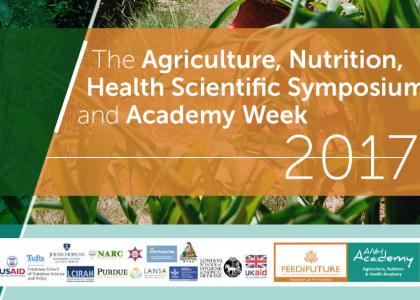
10 minute abstract-driven presentations.
Speakers and Presentations:
Chair: Patrick Webb, Tufts University, USA
-
Prajula Mulmi, Tufts University, Nepal
Household food production is associated with dietary diversity for poorer households and older children: Results from a nationally- representative survey in Nepal
Recording / Slides -
Andrew Thorne- Lyman, JHSPH, USA
Nutritional resilience following the 2015 earthquake in Nepal
Recording -
Ram Chandyo, Kathmandu Medical College, Nepal
Engagement in agriculture protects against food insecurity and adverse child nutritional outcomes in a peri-urban population in Nepal
Recording / Slides -
Johanna Andrews Trevino & Shibani Ghosh, Tufts University, USA
Diet and seasonality as determinants of aflatoxin exposure in pregnant women and birth weights in Banke, Nepal; preliminary results from a birth cohort study
Abstracts:
Household food production is associated with dietary diversity for poorer households and older children: Results from a nationally- representative survey in Nepal
Prajula Mulmi, Tufts University, Nepal
Introduction: Children’s dietary diversity, particularly their intake of more nutrient-dense food groups, is an important influence on nutritional status and health in low-income countries where malnutrition is most widespread. Previous studies in regions with low intake of nutritious foods have found diet quality to be positively associated with their household’s own agricultural production, especially in remote settings far from markets. We add to this literature by identifying modifying effect of household wealth and child age to capture any systematic differences in dietary intake associated with heterogeneity in market access and child nutritional needs.
Methods: We use differences within villages to identify links between household food production and food consumption among children between the ages of 6-59 months by pooling all observations (n= 5,978 children) from the two waves of nationally-representative panel data obtained from the Policy and Science of Health, Agriculture, and Nutrition (PoSHAN) survey in 2013 and 2014. Household food production is captured using novel ways of measuring agricultural production diversity in terms of both food groups and food species grown. Child food consumption is measured using dietary diversity score, whether child meets minimum dietary diversity score (≥4), and consumption of individual food group. Interaction between household wealth quintile and household food production is used to capture modifying effect of wealth. And the sample is split into the following five child-age groups to capture modifying effect of child age: 6-11, 12-17, 18-23, 6-23, and 24-59 months.
Findings and Interpretations: We find strong associations between child dietary diversity and food production diversity in terms of both diversity of food groups and of species grown among poorer households, especially for older children in poorer households, and particularly for nutrient-dense fruits and vegetables, dairy and eggs. With each additional food group produced, log-odds of meeting minimum dietary diversity score (≥4) increase by 0.25 (p=0.01) for children aged 24-59 months. For younger children aged 18-23 months there is a similar effect size but only in the poorest two quintiles of household wealth, and for infants 6-18 months we find no correlation between production and intake in most models. Raising livestock for meat is positively associated with child dietary diversity at all wealth levels, and children consume starchy staples and legumes regardless of their household production.
Conclusions: Household food production is associated with child food consumption and consumption of most nutrient-dense foods, but only among poorer households and older children (≥ 18 months). Findings from the study suggest that farm-diversifying programs intended to improve child dietary diversity are likely to see maximum benefits by targeting the poorest rural farming households and the most nutrient-dense foods, and be accompanied by other policies to reach younger children (<18 months). These findings corroborate and add to previous research on mechanisms and mediating factors linking agriculture to nutrition, with methods and nationally-representative results for Nepal that could potentially generalize to other low-income settings.
Nutritional resilience following the 2015 earthquake in Nepal
Andrew Thorne- Lyman, JHSPH, USA
Introduction: The earthquake that hit Nepal in April, 2015, caused considerable structural damage and loss of life but little is known about the longer-term impacts of the earthquake on nutritional status of preschool children, agricultural loss, household food security, or other risk factors for malnutrition. This analysis provides the first systematic national estimate of the nutritional situation in Nepal following the earthquake, summarizing findings related to damages incurred by rural households one year after the earthquake. At the time of submission, preliminary data were available from this survey more extensive analysis will be presented at the time of the conference.
Methods: The Policy and Science for Health, Agriculture, and Nutrition (PoSHAN) study under the Nutrition Innovation Lab has established a national agriculture-to-nutrition system in Nepal that collects observational panel data annually from a representative sample of ~5500 households in 63 wards across 21 districts, 7 in each of the 3 agro-ecological zones of the country. Within each ward, all households with a child under 5 years of age or a newly married woman were eligible for inclusion. We present data from three annual rounds of data collection conducted at the same sites in the same season each year (2013, 2014, and 2016- post earthquake), including data on agriculture, SES, diet, anthropometry, program participation, and markets. Seven of our VDCs in the hills and mountains were classified as ‘earthquake affected’ by the Government of Nepal. We will present a descriptive analysis and comparison of key characteristics for households and children living in earthquake affected (N=1056 HH, 998 children) and less affected VDC’s (N=1025 HH, 1059 children) in the mountain and hills regions of our sample only, before and one year after the earthquake including child nutritional status, food security, livestock ownership, breastfeeding practices, and trends in the price of key commodities.
Findings and Interpretations: In earthquake affected regions, 6.3% of households had a family member die in the year prior to 2016, and 34.3% of those households reported that the death was due to the earthquake. Injuries among a family member were reported by 16% of those in earthquake affected areas vs. 11.6% of those in not affected areas. Of those living in earthquake affected areas, 20.5% lost crops and 36.1% of those attributed the loss to the earthquake. Nearly a third of households in earthquake unaffected households and 21.1% of those in earthquake affected areas lost livestock or poultry in the year following the earthquake. Preliminary analysis suggests that stunting in earthquake affected areas was lower prior to the earthquake compared with areas classified as not affected (23.1% vs. 48.3%). A year after the earthquake, stunting had decreased in earthquake affected areas (22.0%) but increased in non- affected areas (46.9%). Wasting also declined over the same period in earthquake affected areas (4.5% to 2.1%) and in non affected areas, from 11.5% to 8.5%. Following the earthquake, 87.6% of households in affected areas reported being food secure vs. 65.2% in non affected areas, representing improvements from 82.4% and 57.0% reported prior to the earthquake.
Conclusions: Available data from one year after the earthquake suggests that despite substantial agricultural and other damages incurred by households, the nutrition and food security status of households living in areas defined as ‘earthquake affected’ in our sample appeared to have improved a year after the earthquake than a year before the earthquake. The reasons for this resilience remain unclear but it is possible that it could be due the influx of food and other relief items could be responsible
Engagement in agriculture protects against food insecurity and adverse child nutritional outcomes in a peri-urban population in Nepal
Ram Chandyo, Kathmandu Medical College, Nepal
Introduction: Urbanization is occurring rapidly in many low and middle income countries and livelihoods of food insecure households are shifting accordingly. More than a quarter of all urban dwellers are involved in the agro-food sector. Few studies have explored the associations between periurban household participation in agriculture and their food insecurity, dietary diversity and child or maternal nutritional status.
Methods: A cross-sectional survey of 344 mother-child pairs was conducted in Bhaktapur district Nepal. A structured survey collected data on households’ agricultural practices, livestock ownership, food security, dietary diversity and expenditures was administered, and anthropometric status of mothers and children aged 5-6 years old. The Household Food Insecurity Access Scale and FAO household dietary diversity indicators were used and logistic regression was used to calculate multivariable adjusted and unadjusted odds ratios (AOR and OR respectively).
Findings and Interpretations: Our findings suggest that cultivation of land was associated with a lower risk of child stunting (AOR 0.44, 95% CI 0.25,0.79) and household food insecurity (AOR 0.36, 95% CI 0.20, 0.65), but not low maternal body mass index or anemia. Livestock ownership (mostly chickens) was not associated with child or maternal nutrition outcomes, but livestock-owning households had lower risk of food insecurity (OR 0.46, 95% CI 0.24, 0.88). Households that cultivated land had similar dietary diversity scores than households that did not, but were more likely to consume fruits, vegetables, eggs and milk products, and less likely to consume tubers, legumes, meat and sugar. Households that grew vegetables were more likely to eat vegetables, and children living in households that grew vegetables had a lower risk of stunting (AOR 0.48, 95% CI 0.26, 0.87).
Conclusions: Our study suggests that households involved in cultivation of land in peri-urban Bhaktapur had a lower risk of children’s stunting and of food insecurity, than non-cultivating households -- and that vegetable consumption appears to be enhanced among these households (especially those that grew vegetables). Given Nepal’s rapid urbanization rate, more attention is needed to the potential role of peri-urban agriculture in shaping diets and nutrition.
Diet and seasonality as determinants of aflatoxin exposure in pregnant women and birth weights in Banke, Nepal; preliminary results from a birth cohort study
Johanna Andrews Trevino & Shibani Ghosh, Tufts University, USA
Introduction: Aflatoxins are highly carcinogenic fungal metabolites produced by the Aspergillus flavus and Aspergillus parasiticus fungi. Research in Africa and Asia has linked these toxins with child stunting, but no study has examined the socio-demographic and economic determinants of aflatoxin exposure among pregnant women in Nepal. The Terai region’s hot and humid climate is conducive to aflatoxin proliferation. This could lead to chronic exposure to aflatoxins among vulnerable groups, such as women and their unborn children.
Methods: The USAID-supported AflaCohort Study enrolled 1,675 mother/infant dyads from July 2015 through August 2016. Pregnant women aged 16-49 were recruited from 17 Village Development Committees in Banke district. One venous blood sample was collected from each pregnant woman at recruitment to test for aflatoxin presence (through serum aflatoxin B1 (AFB1) lysine albumin adducts). AFB1 levels were assessed by high-performance liquid chromatography (HPLC) with fluorescence detection, a validated method (US Centers for Disease Control and Prevention) that measures exposure during the past 2-3 months. At recruitment, a questionnaire was administered to all participants to assess sociodemographic and health characteristics, food consumption practices, agricultural and food purchasing, storage and processing practices. Ordinary least squared (OLS), quantile regression (QR) and logistic regression models were used to examine factors associated with serum AFB1 levels in these pregnant women and the association between AFB1 and low birth weight (LBW). Statistical analyses were conducted with Stata® SE version 14.
Findings and Interpretations: Detectable levels (albumin adducts >0.2 pg/mg) were found in 94% (1555/1650) of the pregnant women. The mean serum AFB1 concentration was 3.2 (±8.3) pg/mg albumin (undetectable to 147), with a geometric mean concentration of 1.37 (CI: 1.3-1.4) pg/mg albumin. Factors significantly associated with AFB1 albumin-adduct levels in bivariate analysis, included maternal age, first pregnancy, maternal hemoglobin, maternal mean upper arm circumference (MUAC), seasonality, and maize and groundnut consumption in the preceding week. Groundnut consumption was reported by 32% of the women, maize by 3 % and both groundnuts and maize by 2%. Adduct levels varied remarkably across peanut and maize consumers and non-consumers, mean levels being the highest in those reporting eating both maize and groundnuts in the previous week (7.9 pg/mg albumin adducts) and lowest in those who reported not eating either of these foods (2.4 pg/mg albumin adducts). Mean adduct levels were highest during the pre-winter (Hemanta) and winter (Shishir) seasons, reflecting seasonality in aflatoxin contamination of key staple foods. Adjusting for other socio-economic factors in the OLS model, age (p=0.04), groundnut and/or maize consumption in the past week (p=0.0000), and seasonality (p=0.0000) were significant predictors of high AFB1. The QR results revealed heterogeneity in the size of the effects of groundnut consumption and seasonality on maternal aflatoxin levels. Women who reported one more occasion of groundnut consumption in the past week experienced an increase of 1.03 pg/mg AFB1 albumin adducts for those in the highest quantile (90%). This significant positive effect was higher than the mean effect observed in the OLS point estimate. The effect of prewinter and winter seasons increased for women across all quintiles. The effect of these seasons on maternal aflatoxin exposure in the highest quintile was greater than the mean effects obtained in the OLS regression. Approximately 20% of the infants were born with a LBW. After adjusting for socio-demographic variables and potential confounding factors, findings showed the odds Page | 45 of a LBW infant increased with increase in maternal AFB1 albumin adduct levels (OR=1.14; 95% CI: 1.01-1.28 p=0.031).
Conclusions: Exposure to AFB1 was almost ubiquitous among the pregnant women enrolled in the birth cohort. Levels of exposure were lower than those found in previous studies in Africa and other parts of Asia. Significantly higher levels were found during the pre-winter and winter seasons and in women who had consumed foods susceptible to aflatoxins such as groundnuts and/or maize during the preceding week. Use of QR over OLS allowed closer understanding of the heterogeneity in effect size. High prevalence of LBW was found among the study population with a significant association with aflatoxin levels indicating the need to examine if aflatoxin mitigation strategies would lower low birth weight prevalence in this population. Analysis is being conducted to understand the relationship between dietary patterns, seasonality in relation to crop management and storage practices, food processing techniques, and aflatoxin exposure and other adverse birth outcomes.





